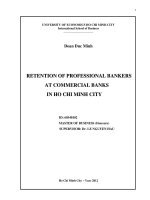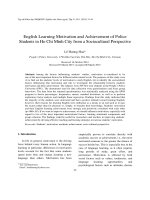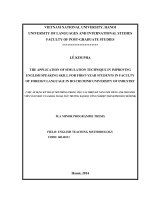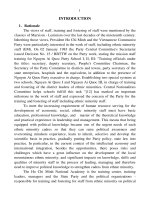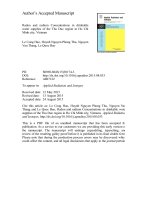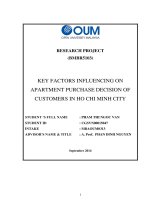Determinants of consumers intention toward online purchasing in ho chi minh
Bạn đang xem bản rút gọn của tài liệu. Xem và tải ngay bản đầy đủ của tài liệu tại đây (1.31 MB, 72 trang )
Advisor’s assessment
.................................................................................................................................
.................................................................................................................................
.................................................................................................................................
.................................................................................................................................
.................................................................................................................................
.................................................................................................................................
.................................................................................................................................
.................................................................................................................................
.................................................................................................................................
.................................................................................................................................
.................................................................................................................................
.................................................................................................................................
.................................................................................................................................
.................................................................................................................................
Advisor’s signature
LISTS OF FIGURES
Figure 1: Proposed model for determinants affect customers’ intention toward online
purchasing ................................................................................................................................ 23
Figure 2: Adjusted model ...................................................................................................... 51
BMBR5103_MBAOUM K15A_NGUYEN THI HANG
Page 1
LISTS OF TABLES
Table 1: a set of Dependent and Independent Variables .................................. 30
Table 2: Demographics of respondants (n=107) ............................................... 37
Table 3: Cronbach’s Alpha of variable “Convenience” ................................... 38
Table 4: Cronbach’s Alpha of variable “Time saving” .................................... 39
Table 5: Cronbach’s Alpha of variable “Website design” ................................ 40
Table 6: Cronbach’s Alpha of variable “Security” ........................................... 41
Table 7: Cronbach’s Alpha of variable “Intention” ......................................... 42
Table 8: Cronbach’s Alpha summary ................................................................ 42
Table 9: Total Variance Explained .................................................................... 44
Table 10: Summary of Loading Factor and Cronbach’s Alpha second time .. 50
Table 11: Summarizes Pearson statistical correlation between the explanatory
variables .............................................................................................................. 52
Table 12: Relevance of the model ...................................................................... 54
BMBR5103_MBAOUM K15A_NGUYEN THI HANG
Page 2
CONTENT
ACKNOWLEDGEMENT .................................................................................. 5
ABSTRACT.......................................................................................................... 6
PART 1: INTRODUCTION ............................................................................... 8
1. Reason to choose the thesis: ....................................................................... 8
2. E-commerce actual situation of Vietnam .................................................. 9
3. Problem statement .................................................................................... 10
4. Research objectives ................................................................................... 11
5. Research questions ................................................................................... 11
6. Contribution .............................................................................................. 12
7. Structure .................................................................................................... 12
PART II: LITERATURE REVIEW ................................................................ 14
1. Understanding of e-commerce ................................................................. 14
1.1
Forms of e-commerce: ........................................................................ 15
1.2
Role of e-commerce: ........................................................................... 16
2. Theoretical literature ................................................................................ 16
2.1
Consumers buying behavior process .................................................. 17
2.2
Theory of Reasoned Action (TRA) ...................................................... 17
2.3
Theory of Perceived Risk (TPR) ......................................................... 18
2.4
Technology Acceptance Model (TAM) ............................................... 20
3. Previous researches: ................................................................................. 21
3.1
Domestic researches:.......................................................................... 21
3.2
International researches:.................................................................... 22
4. Summary ................................................................................................... 22
PART III: METHODOLOGY ......................................................................... 23
1. Conceptual model and hypothesis: .......................................................... 23
1.1
Convenience ........................................................................................ 24
1.2
Time saving ......................................................................................... 24
1.3
Website design/features ...................................................................... 25
BMBR5103_MBAOUM K15A_NGUYEN THI HANG
Page 3
1.4
Security ............................................................................................... 26
1.5
Demographics ..................................................................................... 27
2. Research Method ...................................................................................... 28
3. Measuring scale: ....................................................................................... 28
5. Data collection .......................................................................................... 32
6. Sampling ................................................................................................... 32
7. Sample designing and size ........................................................................ 33
8. Questionnaire designing........................................................................... 33
PART IV: DATA ANALYSIS AND RESULTS ............................................. 35
1. Data analysis methods .............................................................................. 35
2. Demographics description ........................................................................ 36
3. Analysis ..................................................................................................... 37
3.1
Cronbach Alpha: ................................................................................ 37
3.2
Exploratory Factor Analysis (EFA) ................................................... 43
3.3
Correlation analysis using Pearson correlation coefficient............... 52
3.4
Regression analysis ............................................................................ 53
3.5
Hypothesis testing ............................................................................... 56
3.6
Homogeneity of variances testing: ..................................................... 57
3.7
Summary ............................................................................................. 62
PART V: CONCLUSION AND RECOMMENDATION .............................. 63
1. Conclusion ................................................................................................ 63
2. Recommendation ..................................................................................... 64
3. Research limitation .................................................................................. 64
REFERENCE ..................................................................................................... 65
APPENDIX 1 ...................................................................................................... 68
BMBR5103_MBAOUM K15A_NGUYEN THI HANG
Page 4
ACKNOWLEDGEMENT
Firstly, I would like to express my gratitude to Assoc.Prof,Dr, Phan Dinh Nguyen,
my supervisor, for his guidance and help during my process of finishing this thesis.
Secondly, I would like to thank my friends for their support in collecting sample
for this thesis.
Last but not least, I would like to express my appreciation to my family who are
always besides me to give me the inspiration to achieve my goal.
Sincerely
Nguyen Thi Hang
BMBR5103_MBAOUM K15A_NGUYEN THI HANG
Page 5
ABSTRACT
This research is about the determinants of consumers’ intention toward online
purchasing in Hochiminh City. It aims to: (1) clarifying which are determinants
of consumers’ intention toward online purchasing; (2) Giving recommendation
for e-retailers to improve their service for attracting more customers and
developing e-commerce to take advantage of this industry as other countries did.
This research is a descriptive research and mainly processed according to the
quantitative method in order to get precise results. Through implementing
process, it found 4 factors which affect the consumers’ intention toward online
purchasing as: (1) The convenience that e-commerce brings to consumers; (2) Ecommerce help consumers save time for shopping; (3) The good e-commerce
website design attracts consumers to make buying; (4) The security of ecommerce website also attracts consumers to use. Besides, the research model is
considered the effect of demographics of consumers including: Age, Gender,
Income, and Education to their intention of buying online.
The quantitative method is implemented through pre-designed surveying
questionnaires. There are 107 samples of questionnaires were collected and
processed by SPSS 22.0 software.
Multiple regression analysis results showed that the model was met with collected
data and the accepted hypothesis was that the security has positive effect on
consumer’s intention toward buying online. However, there is only 23,9% of the
effect comes from the security factors.
The results of this study will help e-retailers understand deeply which factors has
the most effect on consumer’s intention. So they can improve the function of their
website to ensure the safe for customers when making transaction. And they must
pay attention to the products they provide and customers service including
delivery service and after sale service to reduce the feeling of risk perceiving for
BMBR5103_MBAOUM K15A_NGUYEN THI HANG
Page 6
customers in making transaction online, customers then have more intend to buy
online.
BMBR5103_MBAOUM K15A_NGUYEN THI HANG
Page 7
PART 1: INTRODUCTION
1. Reason to choose the thesis:
E-commerce (electronic commerce or EC) is the buying and selling of goods
and services on the internet, especially the World Wide Web (Tech target, 20072012). And online shopping is a form of E-commerce whereby consumers
directly buy goods or services from the seller through internet. Online shopping
is done through an online shops which are called: e-shops, e-store. All the
products of online shops are showed in text with photo and other type of
multimedia files. In some case, the extra information of products is provided
through link on online shops. According to Cuneyt & Gautam, 2004, online
shopping allows customers to buy faster, more alternatives.
Nowadays, internet has developed and become the base for developing defaults
applications which change the way of communicating and doing business. In
this context, many e-commerce websites have built and merged as the fast,
effective transaction method that utilizing all resources. In fact, the e-commerce
activities have changed the whole economy not only in the way of supplying
goods, but in the spending habits as well.
However, e-commerce in Vietnam has not still been developed and taken its
advantages as it creates in many other countries in the world. During the past
17 years, Vietnam has always ranked in the top 20 countries with the fastest
growth rates of Internet in the world. According to many experts judgement, the
longer time online of consumers the more opportunities for e-commerce or
online services to grow.
In urban areas, about 50% of the population has Internet access. This percentage
is even higher in the two major cities of Hanoi and Ho Chi Minh City. Twothirds of them use the Internet every day, with nearly 50 hours on the Internet
every month. Internet users are in the fairly young age, a higher percentage of
men. 40% of users are presented with the office staff.
BMBR5103_MBAOUM K15A_NGUYEN THI HANG
Page 8
So the main objective of this research is to analyze determinants of consumers’
intention toward purchasing online. This study may contribute not only to a
better understanding on what and how strongly the factors are involved in online
consumer purchasing decisions, but also provides some recommendations for ecommerce businesses in Hochiminh City. But e-commerce businesses should
keep in mind that consumer behavior might change by time, especially in online
market.
2. E-commerce actual situation of Vietnam
There are many researches in Vietnam shown that, there has been more than 90%
internet users for the purpose of information searching. In which, about 30% 40% of users accessed the e-commerce website. This number gives us many
meaning about the potential of e-commerce. According to market research of
NetCitizens, there are more than 50% internet users agree that they can find all
kinds of Goods through e-commerce. However, their belief in the safe of ecommerce is quite low. There are only 14% among those trust in online shopping.
BMBR5103_MBAOUM K15A_NGUYEN THI HANG
Page 9
So, how to recognize the determinants of customers’ intention toward online
purchasing, especially the potential risks of e-commerce? This is the questions
that all retailers must clearly clarify to attract and retain their customers.
3. Problem statement
In recent years, the development of internet in Vietnam is quite fast. According to
the recent survey, Vietnam’s internet growth rate is at 9% annual, rank the 15th
globally. However, the using internet of almost people in Vietnam now is for
news, listening music, chatting, gaming or searching information. There is only
35% of using internet for purchasing online. This percentage is quite low. This
means that the potential for developing e-commerce in Vietnam is still
tremendous. Enterprises who want to expand their business online must think
about how to attract the left percentage of consumers toward purchasing online.
But, the more opportunities to develop for e-commerce have, the more competitors
have. Especially, there are many global e-commerce giant finding chance to
penetrate into the emerging market like Vietnam. And some of them have their
own position and image up till now such as: Lazada. The way they did was to raise
customer’s satisfaction through trust improvement in order to attract customers’
attention. According to Adams 1963, p.347, 1965: “One approach online
companies can do is to ensure distributive fairness and procedural fairness.
Distributive and procedural fairness will trigger the feelings of equity of outputs
(what is received) departed from inputs (what is invested)”, “and of outcomedetermining procedures” (Folger & Greenberg, 1985). So that, “trust and customer
satisfaction will be maintained” (Chiu, Lin, Sun, & Hsu, 2009)
On the other hand, the customer interface quality, perceived security and
perceived usefulness are also important. In the offline commerce, face-to-face
interaction may directly satisfy buyers through supporting services. In ecommerce, salespeople interact via interface of the websites. The online sellers
must face with many challenges, they are to alleviate the uncertainty and
BMBR5103_MBAOUM K15A_NGUYEN THI HANG
Page 10
incomplete or distorted information (Ba & Pavlou, 2002) as well as ensure the
security for sensitive contents and transactions.
In fact, according to a survey of BMI Research Group 2015 on Investors Bank On
Asian e-commerce Prospects, Vietnam has the smallest Asian e-Commerce
market. At 0.1% of the total retail sales, Vietnam E-Commerce market was valued
less than USD0.1bn in 2014 even though PWC News brief Strategy Function of
2013 predicted that the market to reach USD2.8bn by 2015. This means that, the
future of e-commerce in Vietnam is very bright but there still have barriers and
problem to solve.
So this research tries to find out why almost people are not interested in purchasing
online even when this transaction channel provide them more convenient such as:
reducing shopping time with competitive discount price and variety of sellers.
Then giving some recommendation for online sellers to improve their business.
4. Research objectives
Even when e-commerce provides its customers more convenient such as: reducing
shopping time with competitive discount price and variety of sellers. This
distribution channel still attracts little concern from customers. So, with the
purpose of improving intention of customers toward buying online in Hochiminh
City, the overall objectives of this thesis is:
-
To identify determinants influencing consumers’ intention toward
purchasing online
-
To examine how these determinants influence consumers’ intention toward
purchasing online
-
To give recommendations to retailers for improvement of their business.
5. Research questions
BMBR5103_MBAOUM K15A_NGUYEN THI HANG
Page 11
In order to clarify the research objectives, this research aims to cover the following
questions to find the exact answer for e-retailers to improve their business
activities:
-
What are the determinants influencing consumers’ intention toward
purchasing online?
-
How these determinants influencing consumers’ intention toward
purchasing online?
-
What should retailers do to improve their business to increase opportunities
of purchasing from users?
6. Contribution
The results from this research will make a positive contribution to the online
consumer attention literature by providing a deeper understanding of consumer
beliefs about online shopping and how these impact attitude and intention to shop
online. Besides, the information from the research is also useful for retailers to
adapt their strategies to fit customers’ needs and attract & retain customers.
From marketing viewpoint, the research brings useful insight into customer
attention to create marketing plan which quickly responds to online customers’
specific requirement and needs.
7. Structure
This research is divided into seven sections as in the chart below:
BMBR5103_MBAOUM K15A_NGUYEN THI HANG
Page 12
1. Introduction
2. Literature review
3. Methodology
4. Data Analysis and Results
5. Conclusion and
Recommendation
BMBR5103_MBAOUM K15A_NGUYEN THI HANG
Page 13
PART II: LITERATURE REVIEW
In this part, the definition of e-commerce will be given. The previous research and
some key theories that are relevant for understanding more about determinants of
online purchasing intention of customers.
1. Understanding of e-commerce
E-commerce is a tool for reducing administrative costs and improving relationship
among business partners and customers. In fact, the development of internet and
e-commerce has changed the way customer transact and their decision making
process. Through internet, online customers can get all cues which help them to
decide to purchase or not. These cues are the perception, motivation, learning,
attitudes and beliefs. The perception is the way customer select, organize and
interpret information to form knowledge. The motivation is the customers’ desire
to meet their needs. Learning is reflected to customers’ behavior experience rising.
Attitudes are reflected to customers’ steadily favorable or unfavorable
assessments, feelings, and inclinations towards object or ideal.
Normally, each buyer has a limited income, a certain level of knowledge about the
products and purchasing experience. In such conditions, the buyer will have to
decide what products to buy, of whom, with what quantities and selected purchase
method in a way that they can maximize the total satisfaction or their interests of
those products.
The total customers’ benefits is the benefits that customers expect on every
product or certain services, which may include the core benefits of the product,
benefit from the services related to the product, quality and the ability of the
manufacturer's reputation and image of brand, ...
To appreciate the intention toward online purchasing of consumers, in addition to
consider the extent that a product can satisfy the wishes of the buyer, or the
benefits that such products can bring to them, customers can assess through
convenience level of online purchasing; categories/model of online products; the
BMBR5103_MBAOUM K15A_NGUYEN THI HANG
Page 14
level of consumer confidence when shopping online; level of attention on prices,
an assessment of the promotion when buying online.
High convenience is capable, polite attitude and how quickly the purchasing
online is. Buyers without extra effort, time travel, can buy anytime, anywhere;
products are easy to find; purchases quickly and easily; do not disturb by shop
staff and are not afraid to not purchase or cancel an order.
Rich in designs, diversity in model, full products, clear origin & brand obviously
attract consumers, so this is one of the basic methods for retailers enhance
competitiveness in the e-commerce market.
Not only that the retailers must pay attention to build trust with customers, so that
customers can trust and make online purchasing decision. The belief rate is also
the ability to make the payment, commitment to product quality, security of
customer information properly and exactly as promised.
Price is the monetary expression of the products value. Price is an important factor
affecting the selection of consumer toward online purchasing or direct purchasing:
online shopping is cheaper than buying directly or to compare prices between
different vendors, the selling prices is consistent with the quality of goods and
have been clearly marked ...
Promotional activities are promotion of businesses to push products trading and
provision of services to customers for certain benefits. Promotion is used by
businesses flexibly. They often combine multiple forms at once, such as both gifts
and price discount, reduces price & lottery prizes, discounts or gifts in the "golden
hour purchase "of the day (usually the peak hour to stimulate consumer) ...
Discount is usually the popular using form.
1.1 Forms of e-commerce:
The business transactions on the Internet today is in the most popular form of B2B
(business-to-business) and B2C (business-to-consumer). B2B is the kind of
transactions between businesses and organizations together. B2C is the kind
BMBR5103_MBAOUM K15A_NGUYEN THI HANG
Page 15
transactions between businesses and consumers directly. B2B Sales were
evaluated over 90% of total sales e-commerce, meanwhile B2C counted only
about 10% of E-commerce sales. This is understandable, because consumers are
still not familiar with this kind of online shopping. On the other hand, consumers
are still very concerned that the issue of ensuring their privacy on the Internet,
where there is currently no effective form of controlling. Besides, the legal
framework for electronic commerce is still not fully developed and synchronized.
In addition to the above two models, there are also another form of businesses on
the Internet such as:
C2C (consumer-to-consumer) personal direct sales to individuals. Major
applications such as real estate, cars and other consumer goods, exchange
music, software, auction, consulting, sharing experiences etc.
C2B (consumer-to-business): Individuals can search for a business for sale
(goods, software) for businesses. There are many software companies rent
people write software online. Individuals everywhere can participate in
getting contracts of writing software online as required, and then sent over
the network to the company. The company will check the quality of the
product and make payment for individual through bank accounts.
1.2
Role of e-commerce:
Ecommerce has positive impact on society and the economy. It opens to the
economy of the new development. It created more new industries, more jobs,
reduce unnecessary costs, make faster capital turnover, stimulate competition,
stimulate social demand and stimulate the development of products aimed at
maximum satisfaction of consumer needs. It stimulates businesses to be active in
managing and creative search for new business ideas. In summary, Ecommerce is
perfect motivation and promote the development of the economy.
2.
Theoretical literature
BMBR5103_MBAOUM K15A_NGUYEN THI HANG
Page 16
2.1
Consumers buying behavior process
In the field of Consumer behavior research the classical model of consumer
buying behavior is of utmost important. We as persons take actions in purchasing
and using products and services and actions are derived by mental and social
process. Behavioral science helps us to better understand why we go for a certain
product and why not, why we set priories while making decision.
Consumer decision process carries five stages, starting with Problem recognition
and following Information search, Evaluation of alternatives Purchase decision
and finally Post Purchase behavior. Problem recognition starts with the perception
of need and moves towards information search where consumer uses internal and
external sources to analyze given information and use that information in the next
step of evaluation of alternatives. While evaluating alternatives one assessing
values of the products by giving weights. Once you have successfully evaluated
alternatives you will move towards purchase decision where you may encounter
three possibilities, from whom to buy, when to buy and do not buy.
2.2
Theory of Reasoned Action (TRA)
Theory of reasoned action was built by Ajzen Fishbein in late 60s of the 20th
century, and was extended in the70s. According to TRA, behavior intention is the
most important factor predicting consumer behavior. Behavior intention is
affected by two factors: Attitude and Subjective Norm. In which, the attitude is
individual factors expressed positive or negative confidence of consumers toward
products. Subjective norm reflects the influence of social networks on consumers.
When buying a product or a service, consumers often consider their reason of
purchasing to maximize user value based on their payment cost. They could
BMBR5103_MBAOUM K15A_NGUYEN THI HANG
Page 17
consider the type of product purchased including interest and risk (if any), why to
buy, when and where to buy? The purchasing intention of consumers comes as a
result of impact from environment on their consciousness. The characteristics and
decision making process of buyers led to their certain purchase decisions.
Online shoppers are the one who have less time, so they use the internet for
shopping to save time; the one who do not like shopping in stores, they use the
internet to avoid noisy places, queuing or waiting; the one who knows technology
like shopping online because it fits their works. Online shopping behavior is
affected by many factors such as personal characteristics (gender, age, marriage,
education, religion, occupation, income, personality and lifestyle); Environmental
factors (family, social and community); Impact factor from the sellers including:
pricing, advertising, promotion, brand, operations and technical support via the
website, delivery, payment and customer service. These factors directly and
indirectly impact the purchasing intention of customers.
2.3
Theory of Perceived Risk (TPR)
In the theory of perceived risk, Bauer (1960) suggested that consumer behavior
through online website have awareness of risk, which includes two elements: (1)
perception of products/service risk and (2) perceived risks related to online
transactions.
-
Composition risk perceptions relating to products and services: lost
functionality, financial loss, take time, lost opportunities and risk
perceptions towards the entire products/service
-
Composition risk perceptions related to online transactions: the risk can
occur when consumers conduct transactions on electronic media: as a
secret, safety and risk awareness throughout the transaction.
Online shopping is a process where the customer directly buy goods or services
from a vendor in a time authentication through internet. Online sales benefit for
BMBR5103_MBAOUM K15A_NGUYEN THI HANG
Page 18
both buyers and sellers in terms of looking for customers, searching product
information, interactive process and product distribution. For the seller, they can
receive payment from buyers quickly through the internet and cut down
investment cost in distribution system. For buyers, they can purchase anywhere,
regardless of the time, even when at home and access distance vendors.
According to research results of Xiang Yan & Shiliang Dai (2009), online
purchasing decisions are influenced by two groups of factors: perceived benefits
and perceived risks. Cognition of benefits positively influence online purchasing
decisions and perceived risks negatively impact on online shopping decisions.
Before making a purchase, consumers often feel a certain level of risk related to
their choice of a particular brand and how to buy. Bauer (1960) was the first to
introduce the concept of awareness of risks in the purchasing process, which is
considered as the decisive uncertainty of consumers when purchasing. And they
have to accept the consequences of this decision. Cox and Rich (1964) refers to
the concept of perceived risk is the perception level of risk of consumers when
deciding to buy. There is another introduction about the concept of risk awareness
involving uncertainty about the loss of a sale transaction, including six factors:
financial, performance (product not properly in right quality/function), social,
psychological, safety, time. Mitchell (1999) suggests that risk perceptions are
subjective thoughts about determining losses, with two implications are the
uncertainty and negative consequences.
For online shopping, the perceived level of risk is often higher than traditional
shopping, this happens due to the reason that buyers do not see the real picture of
the product and do not directly contact with the salesman (Park & Stoel, 2005).
According Bhatnagar & Ghose (2004), concerning risk factors, there have three
negative impact to online shopping decisions: product risk, financial risk, security
risk about personal information. Axel (2006) showed that compared with product
risks, consumer awareness of the risk of disclosure of personal information have
BMBR5103_MBAOUM K15A_NGUYEN THI HANG
Page 19
a larger impact on the decision to purchase on the internet. McCorkle (1990)
pointed out the risks of online shopping is the seller's fraud, transferred to the
buyer the product unreliable, demonstrating the dishonesty of the seller.
2.4
Technology Acceptance Model (TAM)
The Technology Acceptance Mode - TAM given by Davis (1989), refers to the
elements of cognitive usefulness, ease of use, the attitude and intention to use.
Based on this model, Davis said that the interests of customers for the gain and
the loss can be understood as customer awareness of the benefits and risks. And
as Rauniar et al., 2014, the TAM predicts individual adoption and attitude of
customers willing use technology. Zeithaml (1988) suggested that customers will
have the choice to realize the highest benefits when they make a purchase
decision. In Mitchell (1999) points out that consumers tend to consider the risk
perception rather than maximizing cognitive benefit when they make purchasing
decisions.
Especially TAM-model was simulated based on TRA- model which was widely
recognized as a model of trust and basic modeling acceptance of information
technology (IT) from users.
There are five main variables:
(1) External variable (exogenous), also known as the variables of the previous
experiments: These are the variables affecting the perception of the
usefulness (usefulness perceive-PU) and perceived usability (ease of usePEU perceive).
Examples of external variables such as: training, or different concept in
using the system.
(2) Recognizing the usefulness: Users certainly recognize that the use of a
separate application system will increase the efficiency / productivity of
their work on a specific task.
BMBR5103_MBAOUM K15A_NGUYEN THI HANG
Page 20
(3) Recognizing the ease of use: The easy level that users expect when using
the system.
(4) The attitude towards using: As attitudes towards the use of a system created
by the trust on the usefulness and ease of use.
(5) Intention of using: The user intends to use the system. The intention to use
has the tight relationship with the real use.
According to Davis’s research, perception of usefulness is the main factor that
people determine to use computer and cognition of usability is the second unique
determinants led to the using computer decision.
TAM is considered as typical models for application in the study of the use of a
system for measuring TAM model and predict the use of information systems (IS).
Thus, E-commerce is also a product of the development of information
technology, so the surveyed models of the factor impact in the acceptance of IT is
also applied to research the compatibility issues in e-commerce.
3.
Previous researches:
There were many researches about intention of consumers toward buying
online up to now. This research inherits the model and hypothesis from
those including:
3.1
Domestic researches:
Research about determinants of e-commerce’s willing by Mr. Pham Ba
-
Huy, MBA thesis in 2004. According to Mr. Huy, the determinants of ecommerce’s willing based on the E-CAM model were:
From internal effect, they were: the perceived of usefulness, the
perceived of ease of use, the action of intention
From external effect, they were: website design, advantageous
conditions, and security.
-
Research about perceiving risk of e-commerce toward consumers’
intention of buying online buy Mr. Bui Thanh Trang, University of
BMBR5103_MBAOUM K15A_NGUYEN THI HANG
Page 21
Economics Hochiminh City. From the research results, the perceiving risk
has negative impact on consumes’ intention of buying online which
includes 4 factors: Financial risk; products risk; Information security risk;
and risk from the fraud of sellers.
3.2
International researches:
-
Research about the satisfaction of consumers in online purchasing by
Matthew K O Lee and Christy M K Cheung (2005). In this research, author used
TRA and TPB model to clarify the satisfaction of consumers when making online
purchasing due to the following three factors: Information quality; System quality
and Service quality. In which, the accuracy and content of information, the
displaying information way and the updating situation were the main factors
affecting the information quality. The system quality referred to the perceived ease
of use and security. Lastly, the service quality was about customers’ support, and
customers’ care.
4.
Summary
The research only pays attention to factors affect consumers’ intention toward
online purchasing. If the user has a positive attitude toward e-commerce, they will
have a positive using behavior respectively.
BMBR5103_MBAOUM K15A_NGUYEN THI HANG
Page 22
PART III: METHODOLOGY
This part presents the research methodology including the conceptual model &
hypothesis; research method; and then the variables, the sources of data will be
identified and described
1.
Conceptual model and hypothesis:
The development of e-commerce activities are reflected through attitudes and
buying behavior on the Internet. If the user has a positive attitude towards trading
activity on the Internet, they will have a positive behavior for such operations.
There are many determinants influence a customer’s decision to adopt online
shopping as a way of purchasing. In this research, we propose some hypotheses
regarding customers’ adoption of online shopping which derived from the
previous literature. So the model of this research is:
Figure 1: Proposed model for determinants affect customers’ intention toward
online purchasing
Convenience
H1
(C)
Demographics
Time saving
H2
(TS)
Website
design/features
H5
H3
Online shopping
intention
(WF)
Security
H4
(S)
BMBR5103_MBAOUM K15A_NGUYEN THI HANG
Page 23
1.1
Convenience
Convenience factor refers that it is easy to browse or search the information
through online is easier than the traditional retail shopping. Through online,
consumers can easily search product catalog but if the consumer look generally
for the same product or item in a traditional store manually it is difficult to visit
physically and time consuming also. Convenience has always been a prime factor
for consumers to shop online. Darian (1987) mention that online shoppers carry
multiple benefits in terms of convenience, such as less time consuming, flexibility,
very less physical effort etc. Bhatnagar and Ghose (2004) claims for convenience
as one of the most important advantage for online shopping. According to the
Robinson, Riley, Rettie and Wilsonz (2007) the major motivation for online
purchasing is convince in terms of shop at any time and having bundles of items
delivered at door step.
Rohm and Swaminathan’s (2004) claims in “typology of online shoppers into”:
Convenience shoppers, balanced buyers, variety seekers and store-oriented
shoppers, based upon their preset shopping motivation. Rohm and Swaminathan’s
(2004) findings about ’convenience and variety seeking’ are major motivating
factors of online shopping and this study is consistent with Morganosky and
Cude’s (2000) research findings. Webcheck’s (1999) study shows that
convenience factor is one of the biggest advantages of online shopping. Through
online purchase consumers can easily compare the price than the traditional
purchase. So price comparison is also another convenience factor of online
shopping.
H1: Convenience (C) positively influences customer’s intention in online
shopping
1.2
Time saving
BMBR5103_MBAOUM K15A_NGUYEN THI HANG
Page 24


